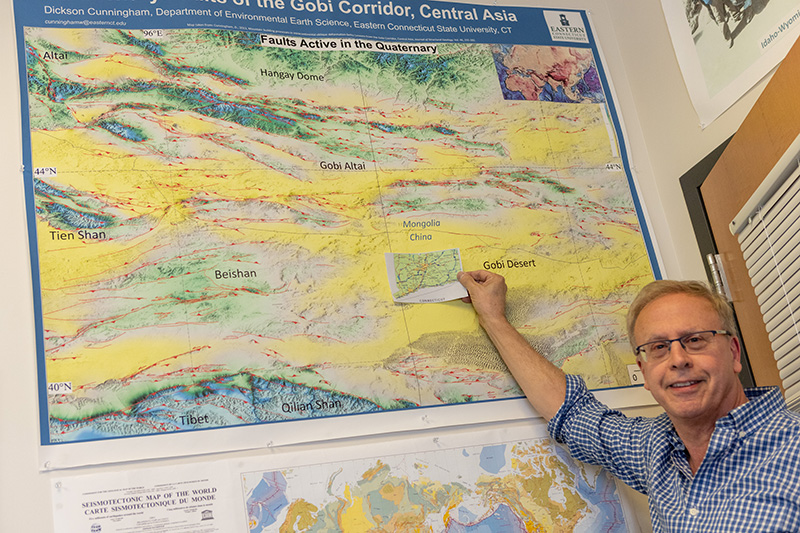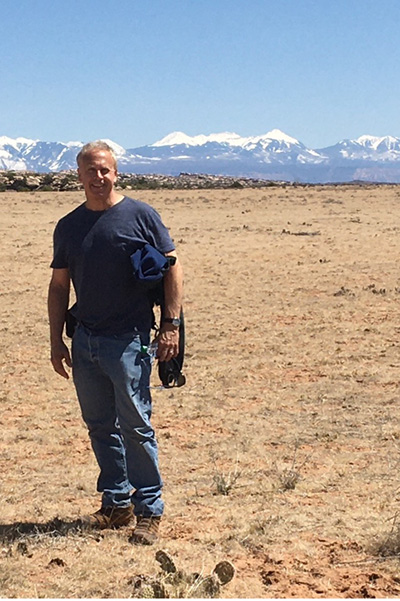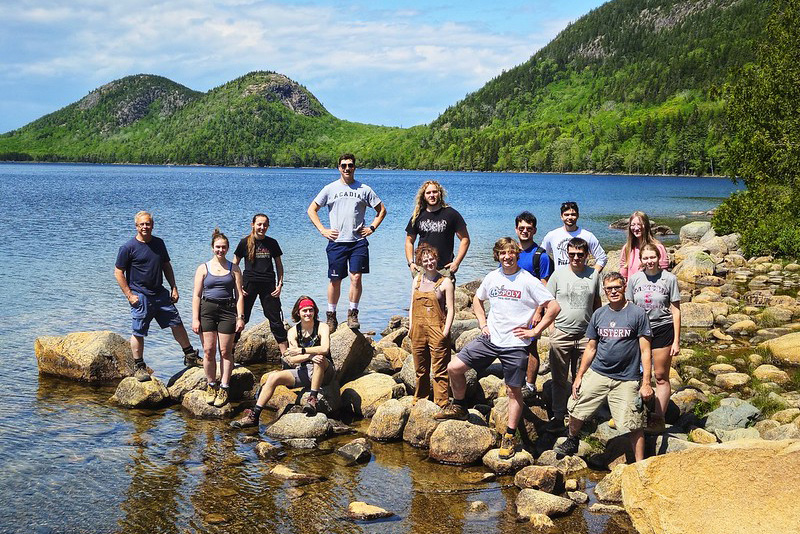- Apply
- Visit
- Request Info
- Give



Published on August 21, 2024

William Dickson Cunningham, professor of environmental earth science at Eastern, didn’t know it then, but when he was four years old he identified what would be his life’s work — learning how mountain ranges form. Tracing his fingers along the bumps on a relief globe, he was “hooked on mountain ranges as a kid,” he said, memorizing the locations and names of all the world’s highest peaks.
He has spent nearly 40 years investigating changes in the Earth’s crust, mainly in central Asia, completing 19 field research seasons in China and Mongolia since 1994. In 2017 he was one of a handful of American scientists invited to speak at a London conference celebrating the 50th anniversary of the discovery of plate tectonics — the theory that the Earth’s outer shell consists of large plates whose slow movement and collisions can result in mountain formation. His research has been funded by the National Science Foundation, the National Geographic Society and the European Union, among others.
Cunningham travels around the world studying his subject. Besides Central Asia, he’s carried out field research in Patagonia, Brazil, the eastern Alps, Cyprus, Antarctica and the western United States. This summer he traveled to the Pyrenees and Vancouver Island.
Nonetheless, the bulk of his research centers on the huge expanses of western China, Mongolia and areas north of Tibet. In 1991, when the Soviet Union broke up and Mongolia opened to Western scientists, his research group was among the first to study the crustal evolution of Mongolia’s Altai Mountains, a range as big as the Alps. Outer Mongolia hadn’t changed much since the time of Marco Polo, he said. The nomadic people he met in the high Altai had never seen a lightbulb, much less a computer.
The area that Cunningham studies is vast. “You can put Connecticut inside Mongolia 109 times,” he pointed out. A single mountain range there is as big as this state. Much of Mongolia and western China is also geologically active, with earthquake hazards along the old Silk Road trade routes and desert towns built atop faults, which provide conduits for surface flow and oasis springs.
North of Tibet, mountain ranges are forming today, the result of pressures still felt from a tectonic event that began 50 million years ago. At that time, the Indian sub-continent broke off from the supercontinent Gondwana and collided with Asia, giving rise to the Himalayas. As a sort of ripple effect traveling at about five centimeters (less than two inches) a year, the stresses from the collision of those two tectonic plates have propagated far to the north, uplifting the Tibetan Plateau and the major mountain ranges north of it as far as southern Siberia, Cunningham said.

The crustal reactivation of Central Asia north of Tibet has been going on for the past 10 million years, which is considered young, geologically. “It’s one of the most active mountain-building regions in the world,” he said. For example, the Tien Shan mountains in China are often called the Switzerland of Asia, with internal massifs, or internal regions, where the summits approach 25,000 feet high.
“The more we worked there, the more exciting it was,” he said, referring to research he began as a faculty member at the University of Leicester, one of the top research universities in the United Kingdom. He first went to Leicester as a NATO postdoctoral fellow, after studying at Dartmouth, the University of Arizona and the University of Texas at Austin and completing an NSF postdoctoral fellowship in Brazil. He stayed on as a senior lecturer at Leicester until 12 years ago, when he moved back to the United States and joined Eastern’s faculty. He is originally from Stony Brook, Long Island.
His main research interest is the structure of mountains, “the architecture of the crust and how mountain ranges form.” His research in China was funded by the Chinese government through geoscientists there who worked and studied with Cunningham. One of these, Haibo Yang, now at the Institute of Geology in Beijing, studied for a year with Cunningham as a visiting scholar at Eastern. Yang is one of the co-authors of Cunningham’s latest paper, published in March in "Geophysical Research Letters," on data they collected in northern Tibet as part of their effort to document faults and the processes of mountain building and earthquake hazards in the interior of the continent.
“By documenting how the mountain ranges of Central Asia are forming today and understanding the network of fault systems that are actively accommodating mountain uplift and creating earthquake hazards, we can better understand the evolution of all of Earth’s continents throughout Earth history,” Cunningham said.
Working in western China has become more complex in recent years, because geopolitical tensions have escalated. This is the area where international attention has focused on the plight of ethnic Muslim groups such as the Uyghurs and the Huis. Travel is also restricted in some areas because western China is home to nuclear test sites and a space launch site. There are also sensitive areas in northern Tibet where Cunningham has traveled. In one case, he was detained inside a village teahouse (with his Chinese hosts) for five hours while the local authorities considered whether to allow him to continue his journey. The entire village came out to peer at him, remarking that they had never had a foreigner in their village before.
“Despite a great appreciation for the beautiful natural scenery, rich culture and wonderful hospitality of the Chinese people, that event kind of took the fun out of it for me, as I feared arrest by the local police force,” he said. Sometimes the local authorities are more suspicious than the central government in Beijing, he noted. “I was told that they may be concerned about journalists coming to the area or even Western spies posing as geologists,” he said.
In any case, he still has a backlog of research data to publish. He has 98 peer-reviewed major publications to date and expects to soon go beyond 100, which was the gold standard at Leicester. His publications have been cited more than 6,400 times and he has given more than 100 research presentations at international conferences and universities on five continents. Eastern, while primarily a teaching university, is also a good base for research, he said, with long summer stretches for fieldwork and paper writing, interesting colleagues, and a great science building with excellent facilities. He still has a network of research collaborators around the world.
Having experienced the Ivy League at Dartmouth and the publishing and grant pressures at a major research university, he appreciates the public liberal arts university model, he said.
“I especially like teaching state university students, because I feel I can make a greater impact on our students’ lives by opening their eyes to all that can be achieved with an EES degree,” he said.

“Geology comes to life in the field,” he said. He has led 50 extended field courses in his career, including 26 in Wales alone. This past May he led a 12-day field course for EES majors titled “Summits and Seashores,” in New Hampshire and Maine.
As former co-chair of Eastern’s Employability Council, he also wants to help students prepare for their careers. Over the past few years, nearly every graduating student in EES was offered a job in their field of interest. All majors in the EES employability course produce polished resumes and Linked In profiles, he said. “Our students also know how to professionally interview and make a 30-second ‘elevator pitch’ for why they should be hired.”
Through campus-wide implementation of the employability plan, he hopes to support the employability of every major at Eastern. “It’s something I believe in strongly because every student wants and deserves a return on their educational investment,” he said.
And while Central Asia is where he has made his biggest research impact, Connecticut and the United States have his attention, too. He has a small project underway studying crustal boundaries in Connecticut, part of how eastern North America formed. He is looking at the faults here, and what are known as the “Moodus noises” — actually shallow earthquakes. This summer, he also expects to complete a paper on a project in Idaho on Yellowstone’s older super-eruption history.
Written by Lucinda Weiss